Do-it-yourself heated supply ventilation: nuances of air heating + instructions for assembling the system
Ventilation systems that provide the influx and processing of air masses coming directly from the street, as a rule, are used exclusively in the economic and industrial sphere. For domestic conditions, such systems are not provided by default. This is one of the reasons that makes ordinary users think about assembling something similar for home use. But is this possible and how can this problem be solved?
By and large, almost anything is possible. However, there are always a number of nuances that should be taken into account. And we will talk about this in our article - we will look at what do-it-yourself heated supply ventilation is and what main components it consists of. Let's discuss the issue of home heating with heating from the point of view of possible solutions to this issue, supplementing the article with visual photos and thematic videos.
The content of the article:
Supply system device with heating function
Technically, the design of the supply air unit is not a high-tech device. True, the latest developments in this area, aimed at providing specialized areas of the national economy with air supply machines, have stepped far forward.
Industrial structures are equipped in accordance with the latest technology:
- control controllers;
- electric motor speed regulators;
- control and analysis sensor systems;
- effective filters and recuperators;
- air heating (cooling) modules;
- channel cut-off mechanisms.
As a result, the treatment of outside air is achieved at a truly high level, which contributes to the creation of a favorable atmosphere inside the work premises.
Is it possible to do something similar for use in a private home?
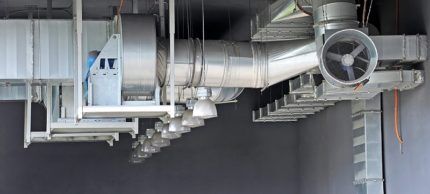
Perhaps, for a single-family private house, such air treatment is quite acceptable.
But for implementation in a city apartment, this is already a difficult task. The complexity of the task for a city dweller is determined by various nuances - both technical and economic.
Design features of the heated “inlet”
To better understand the complexity of the task, let’s consider the classic design of an air supply unit with functions for additional processing of street air.
First of all, the purely installation factor should be taken into account. After all, an air treatment system is a rather large installation that requires the allocation of part of the room area.

The default “inlet” design contains:
- electric motor;
- impeller;
- air capture diffuser;
- air injection diffuser;
- duct shut-off valves;
- filters;
- air channel system.
In order to ensure stable heating of the air flow forced by the fan impeller, a heating system is installed after the discharge diffuser.
For more information about the types of air inlets in an apartment, we talked here.
Types of heating systems for ventilation
Technologically use in conjunction with supply ventilation water or electrical heating system. Or it is possible to use two heating options simultaneously, which, although rare, occurs when operating industrial supply air processing machines.
Implementing a water option in a domestic environment (in an apartment) for arranging ventilation with heated air with your own hands is an extremely difficult task, especially if you plan to operate the supply system in winter conditions.

Water heating requires reliable control and mandatory protection against “defrosting” of the water circuit. To achieve high heating efficiency, the water circuit must be made with a multi-pass, multi-row design. Such a heating device must be removable. We recommend that you read types of water heaters for injection and their operating principle.
The introduction of an electric heater into the design of a home air supply system promises to result in somewhat less difficulties. However, in this case, electricity consumption will inevitably increase, and, accordingly, monthly costs.
To ensure heating of the supply air electrically, it will be necessary to install powerful electric heaters (TEH).
An example of an apartment project with heating
The modern market for technological equipment, in particular, fans and electric heating elements of various designs, theoretically makes it possible to implement a home “warm air supply” project. For example, it is quite possible to consider a design based on duct fan.
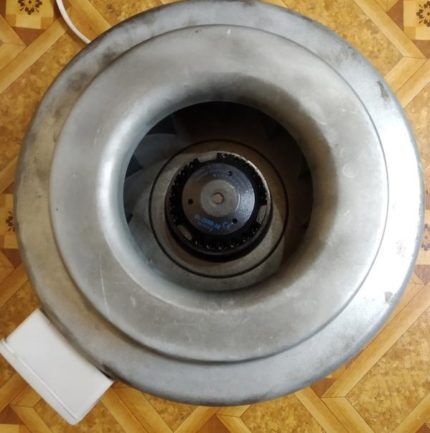
The design of an axial fan, for example, from Dospel, is well suited for an apartment project. This device is small-sized, lightweight, low-noise. The equipment is distinguished by relatively low energy consumption with fairly high productivity. Supports step-by-step speed control, which is also relevant for home “air-fitting” when making it yourself.
However, in addition to the axial duct fan, you will need to select an electric heater (TEH), a design that would ensure full heating of the air mass passed by the fan.
That is, it is necessary to calculate the power of the heating element sufficient for maximum performance of the Dospel device.
For calculations you can use the following formula:
Qt = L * 0.36 * (Tv – Tn),
Where: Qt – heating element power; L – duct fan performance; TV And Tn – air temperature inside and outside.
How to install supply ventilation into an apartment?
It is clear that for the option of a single-family private house, options for supply ventilation with heating provide more opportunities for DIY implementation.
A city apartment sharply limits installation possibilities or allows installation, but with a violation of the overall appearance of the interior. This approach does not suit every city dweller.

This leads to possible options for integrating equipment. So, for cases with city apartments, it would be logical to install a system hidden by suspended ceilings. Moreover, if it is planned to equip the apartment with a “supply” with heating for all existing premises in the apartment.
There are, of course, the simplest variations when supply ventilation with a heating function is introduced directly into the wall of the building. However, this approach is most likely suitable for small rooms in a country house, but not for a city apartment, if we consider a truly high-quality supply of fresh air.
Instructions for arranging a heated “inlet”
Let's consider the option of arranging an apartment with a "supply" with heating in more detail. What needs to be done to implement such a system? Below are step-by-step instructions for assembling the system.
Stage #1 - drawing up a system plan
It sounds trivial, but a plan, even if hastily drawn up on paper, allows you to take into account all the details of construction.
For example, a well-drawn plan necessarily takes into account the presence of insulation of the air duct placed in the body of the wall at the transition section “street - room” (passage unit).
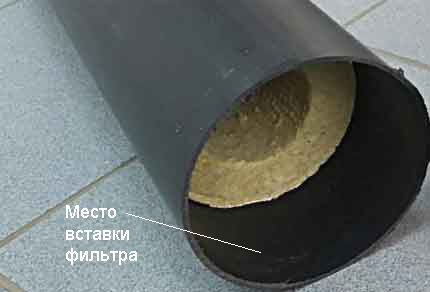
Insulation of this section of the “inlet” with durable modern material is mandatory. Lack of insulation in the transition zone threatens the formation of moisture on the walls of the air duct. This moisture will collect, flow down the pipe and then transfer to the body of the building wall, causing leaks and damage over time.
The layout of the “inlet” arrangement makes it possible to determine in advance the dimensions of each individual part, mark the attachment points, and the exact placement of the system parts. As a result, the time required to carry out work is reduced, plus high-quality installation of equipment is achieved.
Stage #2 - selection of structural elements
The technological components in this case are:
- fan;
- heater (heater or heating element);
- filters (preferably not only coarse cleaning, but also fine cleaning);
- air valve (gate);
- air ducts (rectangular or round).
Each of these structural elements is selected according to size, taking into account previously taken measurements. In addition, components such as the fan and heater require selection for performance and power.
It is possible to make the air filter(s) yourself using suitable material, for example, sipron. Or you can choose ready-made industrial filters. These products are quite affordable.
The air valve (or adjustable damper) installed in front of the fan can also be made with your own hands using suitable sheet material, or you can select a ready-made design for sale.

For home heating with heating, it is recommended to purchase ready-made air ducts, manufactured at an industrial level.
Typically, circular air ducts are considered a convenient option for residential installation. These parts will require holders and fasteners if the project provides for a certain length of the air channel.
Stage #3 - assembly of apartment supply ventilation
Let's consider an example of installing a system with a minimum length of air ducts in an apartment.
So, first you need to punch a hole in the wall of the room where installation is intended. The hole is made commensurate with the cross-section of the air duct, followed by insertion of the inlet part of the pipe into the hole made.
From the outside, the hole is covered with a decorative mesh panel, and the final area facing the room is supplemented with a filter element - inserted into the pipe close to the insulation.
Next, an axial fan is connected to the pipe, at the output of which a heating element (heating element) is installed. Completion of installation - installation of a decorative mesh cover at the end of the outlet channel.
There are (on sale) ready-made duct heaters of round or rectangular cross-section. The obvious point is that a circular heating system is well suited for a ducted axial fan. For example, execution as in the picture below.
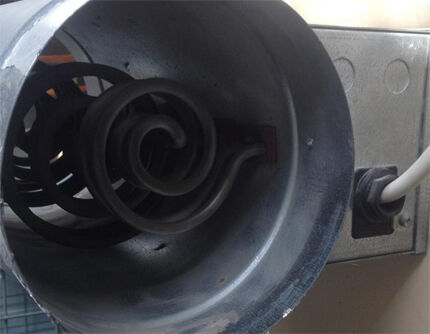
Ready-made heating units of this type are produced in different sizes from 100 mm in channel diameter, weighing from 1.5 kg with a power of up to 6 kW or more.
So, there is every opportunity to choose the appropriate option by creating air heating in the supply ventilation with your own hands for home air supply.
Stage #4 - testing the mounted system
The industrial electric heating module is equipped with all the necessary automatic safety equipment. Therefore, it is recommended to use this option for installation. After assembly in accordance with the attached diagram, all that remains is to test the system.
This procedure involves putting the installation into operation with subsequent monitoring of the trigger factors of temperature sensors to turn on/off the heating element. The operation of the step valve is also checked fan speed controller.
At this point, the installation of the apartment air supply can be considered complete.
Additional components in the “inflow” scheme
Having decided on the selection of the main components of the apartment supply system - a fan and a heater, you should consider options for providing other accessories. In particular, equipping the air handling unit with a coarse air filter. That is, we are talking about creating equipment in a complex.
The rules for the installation of fresh air ventilation necessarily require the introduction of an air filter of cleaning class “EU3”, no less, which must be placed in front of the electric (water) heater. One of the main functions of the filter is to separate small dust particles from the incoming air.
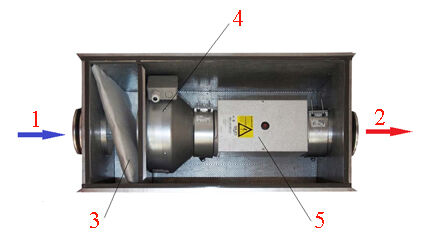
If there is no filter, the electric heating element or water heater quickly becomes dirty, which is fraught with a serious loss of heating power, and for the electrical structure there is also a risk of fire.
The filter installed in the system is required periodically replace with a new one copy, as it gets dirty. Accordingly, a do-it-yourself home structure should provide for the ability to quickly and easily change the filter element.
It is worth noting that industrial air supply structures are usually equipped with differential air pressure sensors. In turn, the sensors are connected to automatic control, which signals the user that the filter is dirty.
In fact, it is also advisable to supplement a serious home air supply system, made by yourself, with a filter condition monitoring function.
Conclusions and useful video on the topic
As an example of the implementation of a home “supply”, although of dubious quality, we offer the video below:
The idea of a heated “air supply” for a city apartment (private house) has a right to exist. Moreover, the possibility of implementing such an idea cannot be ruled out, provided there is a deliberate, rational approach.
It is worth emphasizing: when arranging this kind of system in an apartment or in a house, it would be reasonable to calculate how effective the result will be air exchange. You should also take into account the “drying” factor of the air passed through the heater.Thus, the high-quality implementation of an idea is a complex, ambiguous issue that clearly cannot be resolved on the fly.
Do you still have questions about arranging the heating of the “inlet”? Or would you like to share your own experience in assembling and installing supply ventilation? Ask your questions to our experts, share your experience, take part in the discussion of the issue - you can leave your comments in the feedback block below.



